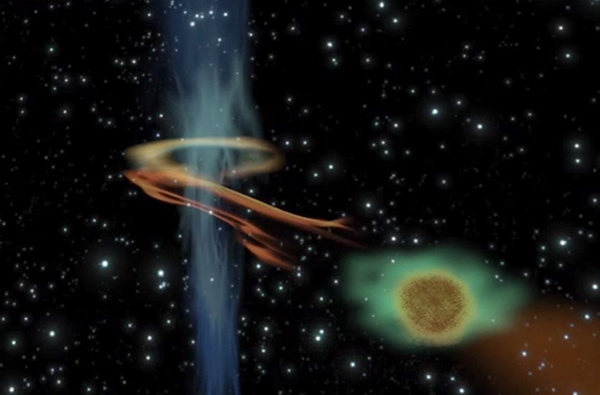Black Hole Wakes Up, Torments and Eats a Planet
Astronomers have watched the sudden brightening of a galaxy and realized it can mean only one thing: a supermassive black hole has “woken up” and feasted after a long period of hibernation. Technically, though, the black hole was always ‘awake’; a large planetary body actually drifted too close and felt the behemoth’s gravitational wrath. That’s what you get for “playing chicken” with an event horizon, I suppose.
The discovery was made by the European INTEGRAL space observatory that keeps an eye on the Cosmos for high-energy gamma-rays and X-rays. While carrying out a study on a different galaxy, INTEGRAL — which stands for INTErnational Gamma-Ray Astrophysics Laboratory — spotted a surprise brightening of NGC 4845, a spiral galaxy some 47 million light-years away. Follow-up observations by ESA’s XMM-Newton, NASA’s Swift and Japan’s MAXI X-ray monitor on the International Space Station confirmed that, despite decades of silence, NGC 4845 just ate a big dinner.
The X-ray brightening reached a peak in January 2011 and then slowly subsided over the course of a year.
“The observation was completely unexpected, from a galaxy that has been quiet for at least 20–30 years,” said Marek Nikolajuk of the University of Bialystok, Poland, lead author of the research published in the journal Astronomy & Astrophysics.
By analyzing the energy of the emissions and the period of time the “feeding” lasted, astronomers were able to calculate the mass of the black hole’s meal. An object with a mass of 14-30 Jupiters had strayed too close, gotten ripped to shreds and formed a short-lived accretion disk around the black hole’s event horizon. This mass is consistent with a large planet or small brown dwarf being eaten alive. The matter then spiraled into the black hole, generating massive quantities of radiation in the process.
Black Hole Wakes Up, Torments and Eats a Planet
But the celestial horrors don’t stop there.
The black hole, weighing in at around 300,000 solar masses, tormented its prey before the “sub-stellar object” was completely pulled apart. The X-ray emissions fluctuated over 2-3 months, suggesting the object passed close, suffered some extreme tidal shear, causing layers of gas to be ripped away before the whole thing was finally consumed.
“This is the first time where we have seen the disruption of a substellar object by a black hole,” said co-author Roland Walter of the Observatory of Geneva, Switzerland.
The timing of the flaring event in NGC 4845 couldn’t have been better. Later this year, a gas cloud is expected to be consumed by the supermassive black hole lurking at the center of our galaxy. The cloud has undergone extreme tidal disruption and astronomers are watching it fall deep into the Milky Way’s galactic core — although we are a safe distance from the cosmic clash, we will likely detect some high-energy fireworks.
Apr 2, 2013 05:18 PM ET by Ian O'Neill












